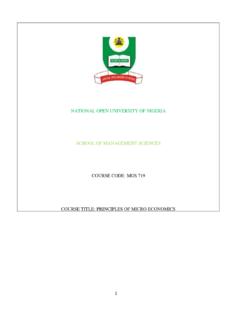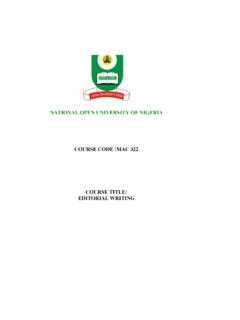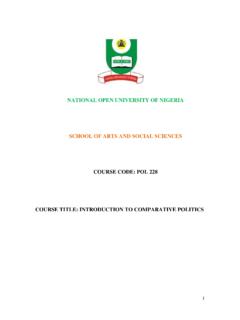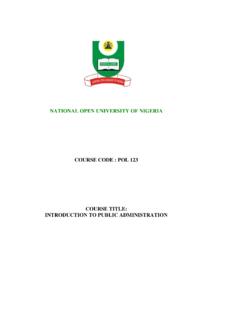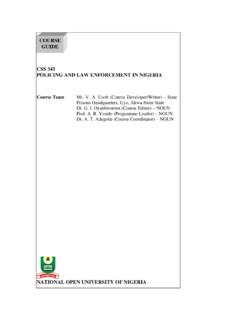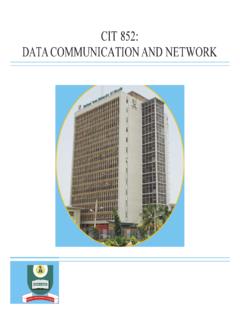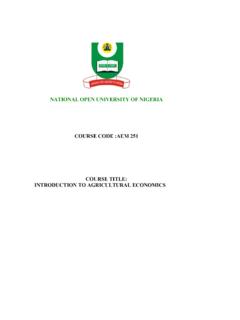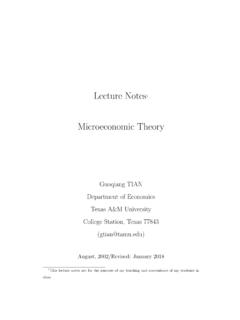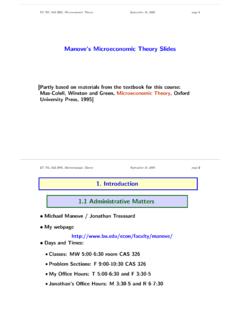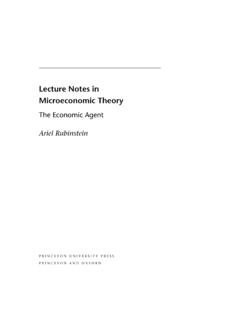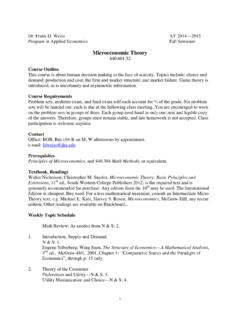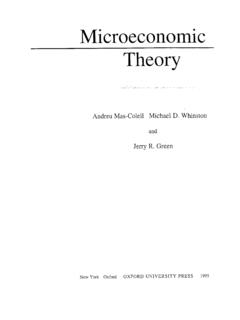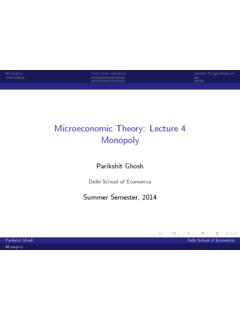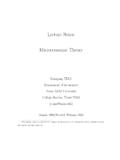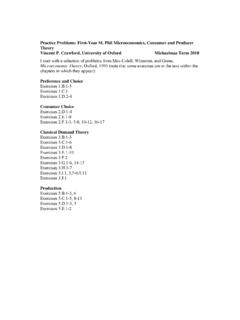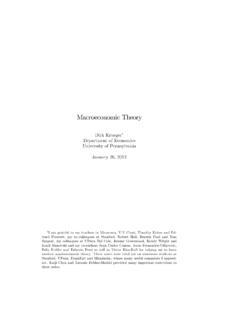Transcription of MICROECONOMIC THEORY II
1 MICROECONOMIC THEORY II. ECO 232. SCHOOL OF ARTS AND SOCIAL SCIENCES. STUDY GUIDE. Course Developer: Adedeji Abiodun Liadi Economics Unit, National Open University of Nigeria Dr Femi Saibu Department of Economics, University of Lagos MICROECONOMIC THEORY II ECO 232. CONTENT. Introduction Course Content Course Aims Course Objectives Working through This Course Course Materials Study Units Textbooks and References Assignment File Presentation Schedule Assessment Tutor-Marked Assignment (TMAs). Final Examination and Grading Course Marking Scheme Course Overview How to Get the Most from This Course Tutors and Tutorials Summary NOUN 2. MICROECONOMIC THEORY II ECO 232. Introduction Welcome to ECO: 232. MICROECONOMIC THEORY II. MICROECONOMIC THEORY II is a three-credit and one-semester undergraduate course for second year Economics student.
2 The course is made up five modules of twenty units spread across fifteen lectures weeks. This course guide builds on the ECO 232 you studied in first semester. It also tells you about the course materials and how you can work your way through these materials. It suggests some general guidelines for the amount of time required of you on each unit in order to achieve the course aims and objectives successfully. Answers to your Tutor Marked Assignments (TMAs) are therein already. Course Content This course is basically an intermediate course on the Micro-economics aspect of economics THEORY . This course builds on the knowledge gained in ECO 201. The focus here is on the use of quantitative methods in analyzing advanced macro-economics. Topics include: the THEORY of demand; the THEORY of production; cost THEORY , general equilibrium THEORY and welfare economics with particular reference to Nigeria.
3 MICROECONOMIC THEORY is quite abstract in nature, hence is one of the most challenging courses students. With this in mind this course material is to help overcome this difficulty by explaining MICROECONOMIC THEORY from a learn-by-doing procedure. However, you should read other current textbooks to supplement to this. Course Aims The aims of this course is to give you in-depth understanding of the economics as regards The behaviour of buyers and sellers in a particular industry in isolation from the conditions prevailing in other industries (market). The way in which households and firms actually pay for their purchases and as well as how individual economic agent and firm interact to meet their needs in an economy. Help you to understand clearly the relationship between input costs and the level of the firm's output. It also introduces the firm's production function, which shows the relationship between inputs used and the level of output those results.
4 Equipping you with a kit of modern tools of economic analysis which will help to understand and analyze the practical economic complexities. NOUN 3. MICROECONOMIC THEORY II ECO 232. Course Objectives To achieve the aims of this course, there are overall objectives which the course is out to achieve though, there are set out objectives for each unit. The unit objectives are included at the beginning of a unit; you should read them before you start working through the unit. You may want to refer to them during your study of the unit to check on your progress. You should always look at the unit objectives after completing a unit. This is to assist the students in accomplishing the tasks entailed in this course. In this way, you can be sure you have done what was required of you by the unit. The objectives serves as study guides, such that student could know if he is able to grab the knowledge of each unit through the sets of objectives in each one.
5 At the end of the course period, the students are expected to be able to: Differentiate between the changes in quantity demanded and change in demand Explain the relationship among total revenue, marginal revenue and price elasticity with the use of graph. Explain how firms transforms resources allocated (input) into product (output) and understand the circular flow of supply and demand between households and firm To explain cost concepts and calculate minimum cost that will enable a producer to produce optimally Why the study of welfare economics is of essence to policy formulation in a country Working through the Course To successfully complete this course, you are required to read the study units, referenced books and other materials on the course. Each unit contains self-assessment exercises called Self- Assessment Exercises (SAE).
6 At some points in the course, you will be required to submit assignments for assessment purposes. At the end of the course there is a final examination. This course should take about 15weeks to complete and some components of the course are outlined under the course material subsection. Course Material The major component of the course, What you have to do and how you should allocate your time to each unit in order to complete the course successfully on time are listed follows: 1. Course guide 2. Study unit 3. Textbook 4. Assignment file 5. Presentation schedule NOUN 4. MICROECONOMIC THEORY II ECO 232. Study Unit There are16 units in this course which should be studied carefully and diligently. MODULE 1: INTRODUCTION AND THEORY OF DEMAND AND SUPPLY. Unit 1: THEORY of Demand Unit 2: THEORY of Supply Unit 3: The Market Mechanism Unit 4: Elasticity of Demand and Supply MODULE 2: THEORY OF PRODUCTION.
7 Unit 1: THEORY of Production I. Unit 2: THEORY of Production II. Unit 3: THEORY of Production III. Unit 4: THEORY of Production IV. MODULE 3: THEORY OF COST. Unit 1: THEORY of Cost: Introduction Unit 2: THEORY Cost II. Unit 3: THEORY Cost III. Unit 4: THEORY Cost IV. MODULE IV: GENERAL EQUILIBRIUM THEORY AND WELFARE. ECONOMICS. Unit 1: Introduction to General Equilibrium Concept Unit 2: General Equilibrium in Production and Exchange Unit 3: Welfare Economics I. Unit 4: Welfare Economics II. Each study unit will take at least two hours, and it include the introduction, objective, main content, self-assessment exercise, conclusion, summary and reference. Other areas border on the Tutor-Marked Assessment (TMA) questions. Some of the self- assessment exercise will necessitate discussion, brainstorming and argument with some of your colleagues.
8 There are also textbooks under the reference and other (on-line and off-line) resources for further reading. They are meant to give you additional information if only you can lay your hands on any of them. You are required to study the materials; practice the Self-Assessment Exercise and Tutor-Marked Assignment (TMA) questions for greater and in-depth understanding of the course. By doing so, the stated learning objectives of the course would have been achieved. NOUN 5. MICROECONOMIC THEORY II ECO 232. Textbook and References For further reading and more detailed information about the course, the following materials are recommended: Emery (1984): Intermediate microeconomics , Harcourt brace Jovanovich, Publishers, Orlando, USA. Jhingan (2009): microeconomics THEORY , Vrinda Publications (P) Limited, Delhi Karl and Line C. F (2007):Principles of microeconomics , Pearson Education International, New Jersey, USA.
9 Kelvin L. and Lipsey R. G., The General THEORY of the Second Best, Review of Economic Studies 24. Koutsoyiannis A. (1979): Modern microeconomics 2ed., Macmillan Press Limited, Hampshire, London. Nicholson W. and Snyder C. (2010): Intermediate microeconomics 11Ed., South- Western Cengage Learning, Mason, USA. O'Sullivan A. and Sheffrin (2002): microeconomics : Principles And Tools: Pearson Education, New Jersey, USA. Pindyck and Daniel L. R. (2009): microeconomics (7ed), Pearson Education, Inc. New Jersey, USA. Salvatore D. (2003): microeconomics Harper Publishers Inc. New York. USA. Salvatore D. (2006): microeconomics . Schuams Series. McGraw-Hill Companies, Inc. USA. Truet and Truet (1984): Intermediate Economics; West Publishing Company, Minnesota, USA. Umo (1986): Economics, African Perspective; John West publications Limited, Lagos.
10 NOUN 6. MICROECONOMIC THEORY II ECO 232. Assignment File Assignment files and marking scheme will be made available to you. This file presents you with details of the work you must submit to your tutor for marking. The marks you obtain from these assignments shall form part of your final mark for this course. Additional information on assignments will be found in the assignment file and later in this Course Guide in the section on assessment. There are four assignments in this course. The four course assignments will cover: Assignment 1 - All TMAs' question in module 1 Unit 1 24. Assignment 2 - All TMAs' question in module 2 Unit 4 96, 101. Assignment 3 - All TMAs' question in module 3 Unit 3 128. Assignment 4 - All TMAs' question in module 4 Unit 2 159, 165. Presentation Schedule The presentation schedule included in your course materials gives you the important dates for this year for the completion of tutor-marking assignments and attending tutorials and group discussion.
